Lockheed T-33 Shooting Star Videos
|
Loading...
|
|
Lockheed T-33 Shooting Star
T-33 Shooting Star
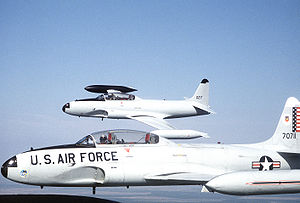
Picture - Two T-33s from the 95th Fighter Interceptor Training Squadron in flight near Tyndall AFB, Florida. The farther aircraft has been repainted and renumbered in anticipation of its delivery to the Mexican air force.
Role: Training aircraft
Manufacturer: Lockheed
Designed by: Clarence "Kelly" Johnson
First flight: 22 March 1948
Primary users: United States Air Force
United States Navy
Japan Air Self Defense Force
Luftwaffe
Produced: 1948-1959
Number built: 6,557
Developed from: P-80 Shooting Star
Variants: T2V/T-1A Seastar
Canadair T-33
The Lockheed T-33 Shooting Star is an American-built jet trainer aircraft. It was produced by Lockheed and made its first flight in 1948, piloted by Tony LeVier. The T-33 was developed from the Lockheed P-80/F-80 starting as TP-80C/TF-80C in development, then designated T-33A. It was used by the U.S. Navy initially as TO-2 then TV-2, and after 1962, T-33B. Despite its vintage, the venerable T-33 still remains in service worldwide.
Design and development
The T-33 (aka "T-Bird") was developed from the Lockheed P-80/F-80 by lengthening the fuselage by slightly over three feet and adding a second seat, instrumentation and flight controls. It was initially designated as a variant of the P-80/F-80, the TP-80C/TF-80C.
Design work for the Lockheed P-80 began in 1943 with the first flight on 8 January 1944. Following on the Bell P-59, the P-80 became the first jet fighter to enter full squadron service in the United States Army Air Forces. As more advanced jets entered service, the F-80 took on another role - training jet pilots. The two-place T-33 jet was designed for training pilots already qualified to fly propeller-driven aircraft.
Originally designated the TF-80C, the T-33 made its first flight on 22 March 1948 with US production taking place from 1948 to 1959. The US Navy used the T-33 as a land-based trainer starting in 1949. It was designated the TV-2, but was redesignated the T-33B in 1962. The Navy operated some ex-USAF P-80Cs as the TO-1, changed to the TV-1 about a year later. A carrier-capable version of the P-80/T-33 family was subsequently developed by Lockheed, eventually leading to the late 1950s to 1970s T2V-1/T-1A SeaStar. A total of 6,557 Shooting Stars were produced, 5,691 by Lockheed.
Operational history
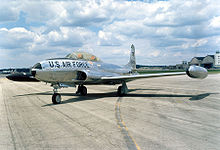
Picture - Lockheed T-33A USAF
The two-place T-33 proved suitable as an advanced trainer, and it has been used for such tasks as drone director and target towing. The U.S. Air Force began phasing the T-33 out of front line pilot training duties in the Air Training Command in the early 1960s as the T-37 Tweet and T-38 Talon aircraft began replacing it under the Undergraduate Pilot Training (UPT) construct. Similar replacement also occurred in the U.S. Navy with the TV-1 (also renamed T-33 in 1962) as more advanced aircraft such as the T-2 Buckeye came on line. USAF and USN versions of the T-33 soldiered on into the 1970s and 1980s with USAF and USN as utility aircraft and proficiency trainers, with some of the former USN aircraft being expended as full scale aerial targets for air-to-air missile tests from naval aircraft and surface-to-air missile tests from naval vessels. Several T-33s were assigned to USAF F-101 Voodoo, F-102 Delta Dagger and F-106 Delta Dart units, to include similarly equipped Air National Guard units, of the Aerospace Defense Command as proficiency trainers and practice "bogey" aircraft. Others later went to Tactical Air Command and TAC-gained Air National Guard F-106 and F-4 Phantom II units in a similar role until they were finally retired.
Some T-33s retained two machine guns for gunnery training, and in some countries, the T-33 was even employed as a combat aircraft: the Cuban Air Force used them during the Bay of Pigs Invasion, scoring several kills. The RT-33A version, reconnaissance aircraft produced primarily for use by foreign countries, had a camera installed in the nose and additional equipment in the rear cockpit. T-33s continued to fly as currency trainers, drone towing, combat and tactical simulation training, "hack" aircraft, electronic countermeasures and warfare training and test platforms right into the 1980s.
The T-33 has served with over 30 nations, and continues to operate as a trainer in smaller air forces. Canadair built 656 T-33s on licence for service in the RCAF - Canadian Forces as the CT-133 Silver Star while Kawasaki manufactured 210 in Japan. Other operators included Brazil, Turkey and Thailand which used the T-33 extensively.
In the 1980s, an attempt was made to modify and modernize the T-33 as the Boeing Skyfox, but a lack of orders led to the cancellation of the project. About 70% of the T-33s airframe was retained in the Skyfox, but it was powered by two Garrett AiResearch TFE731-3A turbofan engines.
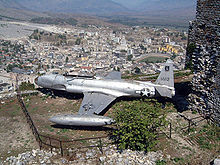
Picture - United States Air Force Lockheed T-33 reconnaissance plane forced down in December 1957, on display in Gjirokastx«r, Albania.
In the late 1990s, 18 T-33 Mk-III and T-33 SF-SC from the Bolivian Air Force went to Canada to be modernized at Kelowna Flightcraft. New avionics were installed, and detailed inspection and renewal of the fuselage and wings were performed. Most of the aircraft returned in early 2001 and remain operational.
A limited number of T-33s have found their way into private hands; some current owners: Michael Dorn of Star Trek: The Next Generation fame, Canadair T-33. and northern California based Greg Colyer of the T33 Heritage Foundation who operates a Canadair CT-33 Silver Star monikered "Ace Maker".
On 6 September 2006, Imperial War Museum Duxford's Canadair T-33 (G-TBRD), owned by the Golden Apple Trust, was destroyed in a takeoff accident; the crew survived. G-TBRD was the first jet warbird to be operated from Duxford, arriving in 1975; it was originally registered as G-OAHB.
In 2008, several T-33s in storage at CFB Mountain View, an old World War II era RCAF base south of Trenton, Ontario, were sold to various private collectors. Six airplanes were purchased by a newly formed museum out of London, Ontario, called the Jet Aircraft Museum (JAM), associated with the Canadian Harvard Aircraft Association, which purchased the aircraft on behalf of JAM. The six airplanes, formerly designated #133346, now C-FUPM; #133500, now C-FUPO; and #133573, now C-FUPP, as well as #133052, #133263 and #133441, will be flown in airshows and for memorials across Canada and in parts of the USA. Other T-33s have also been sold to various US and Canadian buyers.
In 2010, a T-33 Shooting Star was used as a chase aircraft during the maiden flight of the Boeing 787 and Boeing 747-8
Variants
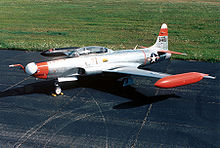
Picture - Lockheed NT-33A USAF
USAF
T-33A: Two-seat jet trainer aircraft.
AT-33A: Two-seat attack version of the T-33A.
DT-33A: This designation was given to a number of T-33As converted into drone directors.
NT-33A: This designation was given to a number of T-33As converted into special test aircraft.
QT-33A: This designation was given to number of T-33As converted into target drones.
RT-33A: Two-seat reconnaissance version of the AT-33A.
US Navy
TO-1/TV-1: U.S. Navy designation of P-80C, 50 transferred to USN in 1949 as jet trainers (not technically T-33 Shooting Star)
TO-2: Two-seat land-based jet training aircraft for the US Navy. It was the US Navy's version of the T-33A. Later redesignated TV-2.
TV-2KD: This designation was given to number of TV-2s converted into drone directors.
T-33B redesignation of Navy's TV-2 in 1962.
DT-33B redesignation of Navy's TV-2KD.
Canada
CT-133 Silver Star : Two-seat jet trainer for the RCAF/ Canadian Forces (also communications, target towing and electronic warfare duties).
Operators
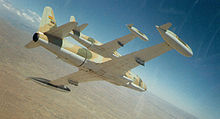
Picture - Two T-33s of the Bolivian Air Force
Belgium
Belgian Air Force (38 x T-33A, 1 x RT-33A operated from 1952)
Bolivia
Bolivian Air Force 34- T-33
Brazil
Brazilian Air Force (all retired)
Burma (all retired) Canada - See Canadair T-33
Royal Canadian Air Force
Royal Canadian Navy
Canadian Forces
National Research Council
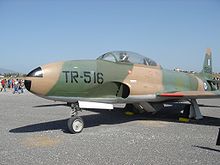
Picture - A T-33 Shooting Star of the Hellenic Air Force
Chile (all retired) Republic of China
Republic of China Air Force (all retired)
Colombia
Colombian Air Force (all retired)
Cuba
Cuban Air Force (all retired)
Denmark
Royal Danish Air Force(all retired)
Dominican Republic
Dominican Air Force AT-33A-LO (AT-33 Silver Star)
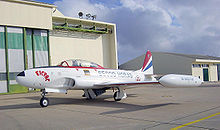
Picture - T-33 Portuguese Air Force
Ecuador (all retired) El Salvador (all retired) France (all retired) Germany
Luftwaffe (all retired)
Greece
Hellenic Air Force (all retired)
Guatemala
(One is on static exhibit outside the east entrance to the Mundo Maya International Airport near Flores, restored to polished aluminum finish) (all retired)
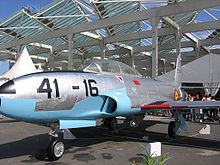
Picture - T-33 Spanish Air Force
Honduras (all retired) Indonesia (all retired) Iran (all retired) Italy (all retired) Japan (all retired)
Japan Air Self Defense Force manufactured by Kawasaki Heavy Industries Aerospace Company from 1956. (all retired)
Libya (all retired) Mexico
Mexican Air Force: (all retired)
Netherlands
Royal Netherlands Air Force (all retired)
Nicaragua
Fuerza Aérea de Nicaragua FAN received delivery of four AT- 33A aircraft from the US Government after the failed Bay of Pigs invasion in 1961.Retired from service in 1979 (all retired)
Norway
Royal Norwegian Air Force (all retired)
Pakistan
Pakistan Air Force (all retired)
Paraguay
Paraguayan Air Force operated six AT-33A donated by Taiwan in 1990. The belonged to the Grupo Aerotx¡ctico (GAT) 2nd. Fighter Squadron called "Indios". They were withdrawn from use in 1998.
Peru (all retired) Philippines
Philippine Air Force (all retired)
Portugal
Portuguese Air Force (all retired)
Saudi Arabia (all retired) Singapore
Republic of Singapore Air Force: ex-French Air Force (Armée de l'Air) machines, (all retired)
South Korea
Republic of Korea Air Force: T-33A is First introduction Time: August, 1955. It also served with the ROKAF Black Eagles aerobatic team, (all retired)
Spain
Spanish Air Force (all retired)
Thailand
Royal Thai Air Force (all retired)
Turkey
Turkish Air Force (all retired)
United States
Boeing Commercial Airplanes
United States Air Force (all retired)
United States Navy (all retired)
Uruguay (all retired) Yugoslavia (all retired)
Survivors
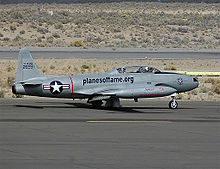
Picture - A Lockheed T-33 in Reno, Nevada in 2004
Numerous T-33s have been preserved as museum and commemorative displays including:
Albania
T-33A-1-LO, 14413 (51-04413), USAF forced to land in December 1957 at Rinas Airport (Albania) by a squadron of 2 Albanian MiG-15bis - in static display at Gjirokastra Museum -
Brasil
Unknown T-33, on static display in the Brazilian Museu Aeroespacial - Musal in Rio de Janeiro.
Canada
Former Royal Canadian Air Force (RCAF) #133346,#133500,#133573 respectively registered as C-FUPM,C-FUPO,C-FUPP restored to flying condition with the Jet Aircraft Museum, London, Ontario.
Former Royal Canadian Air Force (RCAF) #133052,#133263,#133441 under restoration to flying condition with the Jet Aircraft Museum, London, Ontario.
Former Royal Canadian Air Force (RCAF) on a plinth, Pictou, Nova Scotia.
First RCAF T-33 21001 purchased by Lynn Garrison in 1964 for display. Now on a plinth in Edmonton, Alberta.
Germany
Unknown T-33, on static display in the Deutsches Museum Flugwerft SchleixŸheim near Munich. It carries the markings of the German Luftwaffe.
Japan
JASDF Air Development and Test Command (航空開発実験集団) T-33A "61-5221" is on display at the Kakamigahara Aerospace Science Museum(ja), Kakamigahara, Gifu.
JASDF 8th Air Wing (ja) T-33A "71-5293" is on display at the Amagi Railway Amagi Line Tachiarai Station(ja), Chikuzen, Fukuoka.
Philippines
T-33 on display on Philippine Air Force Museum at Villamor Air Base
Saudi Arabia
T-33A on display at the Royal Saudi Air Force Museum, Riyadh.
Serbia
T-33A-1-LO, 58-8189 is in the Yugoslav Aeronautical Museum in Belgrade.
T-33A-1-LO, 52-9958 Yugoslav 10024 (serial number: 580-8189) is on display at Yugoslav Aeronautical Museum, Nikola Tesla Airport, Belgrade.
South Korea
T-33A on display at the War Memorial of Korea, Seoul.
Taiwan
T-33, 57-0532, on display at Chung Cheng Aviation Museum.
Thailand
Unknown T-33A, on display at Royal Thai Air Force Museum, Don Muang AFB.
United Kingdom
T-33A-1-LO, 51-4419 and 17473: On loan from the USAF Museum at the Midland Air Museum, Coventry.
T-33A, 55-4439, On display at the North East Aircraft Museum, Sunderland.
United States
T-33A-1-LO, 53-5974, is on display at the National Museum of the United States Air Force at
Wright-Patterson Air Force Base, OH.
T-33A-1-LO, 51-4301 is on static display at Vance Air Force Base, Oklahoma.
T-33A-1-LO, 58-0629 is on display at Castle Air Museum at the former Castle Air Force Base in Atwater, California.
The town of Othello, Washington in the United States has a decommissioned T-33 on display in a park near the City Hall.
T-33A-1-LO, 58-0616 is on display at McChord Air Museum, McChord Air Force Base, Washington.
T-33A-1-LO, 51-2129? is in display at the Collings Foundation in Stow, Massachusetts.
T-33A-5-LO, 53-5226N is on display at the National Air and Space Museum's Steven F. Udvar-Hazy Center.
T-33A, 52-9497 is on display at the Air Mobility Command Museum, Dover Air Force Base, Delaware
T-33A, 58-0542 is mounted outside the JROTC Gen C Powell Hall (Central High School JROTC, TX-936) on Highway 67 in San Angelo, Texas. Formerly N10265 at Texas State Technical College in Waco.
T-33A on display at Jacksonville Air National Guard Base, Florida
T-33A on display at Masonic Lodge WILLACOOCHEE, Georgia
T-33A on display at National Guard Armory Waynesboro, Georgia
T-33, 53-421, Modified as a play structure at Oak Meadow Park Los Gatos, California.
T-33 located at Southeast Iowa Regional Airport in Burlington, Iowa.
2 unknown T-33s, on static display at the Naval Air Station Wildwood Aviation Museum, Cape May, New Jersey
Unknown T-33, is under restoration to flying condition with the Collings Foundation out of their Houston, Texas facility.
Unknown T-33, on static display, city park Hart, Michigan.
Unknown T-33, on static display at the Franklin Institute, Philadelphia, Pennsylvania; painted as USAF tail number 0-36038.
T-33 on static display at Harrison County Airport, Cadiz, Ohio, USA, tail USAF #29785.
T-33 USAF tail #36053 on static display at Tiger Stadium, Louisiana State University Campus, Baton Rouge.
Unknown T-33 on static display at a VFW post in Wilmington, North Carolina.
Unknown T-33 in storage at Carolinas Aviation Museum, Charlotte-Douglas International Airport, Charlotte, North Carolina.
2nd Unknown T-33 in storage at Carolinas Aviation Museum, Charlotte-Douglas International Airport, Charlotte, North Carolina.
T-33A 35979 is on display at the Prairie Aviation Museum in Bloomington, Illinois.
T-33 on display at the Palm Springs Air Museum, Palm Springs, California.
T-33A USAF Tail #19263 on static display at City Hall of Brooklyn, Ohio, USA.
T-33A USAF Tail #0416988 on static display in Williams Park in Gibsonburg, Ohio.
T-33A USAF on static display at Hector Municipal Airport in Hector, Minnesota.
Uruguay
4 unknown T-33s, on static display at :
Uruguayan Air Force Airbase #2 (St. Bernardina, Durazno)
Airbase #1 (Carrasco Intl. Airport)
ETA (Technical Air School)
Cnel. (Av.) Jaime Meregalli.Museo Aeronx¡utico (Air Museum)
Specifications (T-33A)
General characteristics
Crew: Two
Length: 37 ft 9 in (11.2 m)
Wingspan: 38 ft 10.5 in (11.5 m)
Height: 11 ft 8 in (3.3 m)
Empty weight: 8,300 lb (3,775 kg)
Max takeoff weight: 15,100 lb (6,865 kg)
Powerplant: 1x— Allison J33-A-35 centrifugal compressor turbojet, 5,400 lbf (23 kN)
Performance
Maximum speed: 600 mph (970 km/h)
Range: 1,275 mi ferry (2,050 km)
Service ceiling: 48,000 ft (14,600 m)
Armament
Guns: 2 x— 0.50 in (12.7 mm) Browning M3 machine guns with 350 rpg (for AT-33)
Hardpoints: 2 with a capacity of 2,000 lb (907 kg) of bombs or rocket pods
Related development
P-80 Shooting Star
Canadair T-33
T2V/T-1A Seastar
Boeing Skyfox
Comparable aircraft
T-38 Talon
T-2 Buckeye
Bibliography
Baugher, Joe. "Lockheed P-80/F-80." Lockheed P-80/F-80. Retrieved: 21 December 2006.
Davis, Larry. P-80 Shooting Star. T-33/F-94 in action. Carrollton, Texas: Squadron/Signal Publications, 1980. ISBN 0-89747-099-0.
Dorr, Robert F. "P-80 Shooting Star Variants". Wings of Fame Vol. 11. London: Aerospace Publishing Ltd., 1998. ISBN 1-86184-017-9.
Hiltermann, Gijs. Lockheed T-33 (Vliegend in Nederland 3) (in Dutch). Eindhoven, Netherlands: Flash Aviation, 1988. ISBN 978-90-71553-04-2.
Pace, Steve. Lockheed Skunk Works. St. Paul, Minnesota: Motorbooks International, 1992. ISBN 0-87938-632-0.
Lockheed T-33 Shooting Star Pictures and Lockheed T-33 Shooting Star for Sale.
Living Warbirds: The best warbirds DVD series.
Source: WikiPedia